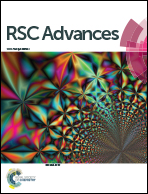High stability and superior catalytic reactivity of nitrogen-doped graphene supporting Pt nanoparticles as a catalyst for the oxygen reduction reaction: a density functional theory study†
Abstract
We investigated the structural and electronic properties of Pt13 nanoparticles on various nitrogen (N)-doped graphene and their interaction with O by density functional theory (DFT) calculations. The results revealed that the N-doping can greatly enhance the binding strength of Pt13 nanoparticles on the graphene surface, thus ensuring their high stability. For NC doping (N atoms directly substituting for C atoms), the enhanced binding strength of the Pt13 cluster is attributed to the activation of the carbon atoms around the N-dopant, while the strong hybridization of the d states of the Pt13 cluster with the sp2 dangling bonds of the N atoms in defective N-doped graphenes contributes to the strong adsorption. Moreover, a certain amount of electrons are transferred from Pt13 to the substrate accompanied by a substantial downshift of the Pt13 d-band center, thus greatly weakening the interaction of O on these composites: the adsorption energy of O is reduced from −3.700 eV on freestanding Pt13 nanoparticles to −1.762, −1.723, and −1.507 eV on deposited Pt13 ones on NC, 3NV, and 4ND structures, respectively. Hence, it is expected that N-doped graphene supported Pt nanoparticles exhibit super catalytic reactivity in the ORR.


 Please wait while we load your content...
Please wait while we load your content...